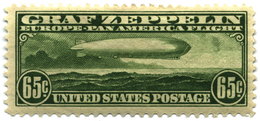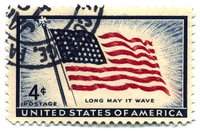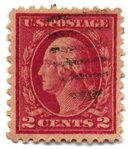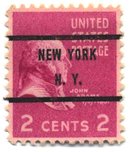Postage stamps and postal history of the United States
|
|
This is a survey of the postage stamps and postal history of the United States.
| Contents |
Early postal history
(add pre-stamp postal history here)
Provisionals
The introduction of postage stamps in Great Britain in 1840 was received with great interest around the world, and in the United States. On March 3, 1845, Congress reduced and regularized postal rates, with a uniform rate of five cents for distances under 300 miles. However, Congress did not authorize the production of stamps, so postmasters made provisional issues. These included both prepaid envelopes and stamps, mostly of crude design, the New York Postmaster's Provisional being the only one of quality comparable to later stamps. The provisionals of Baltimore were notable for the reproduced signature of the city's postmaster - James Buchanan, later President of the United States. All of the provisionals are rare, and several command prices above US$100,000. These cities issued provisionals in 1845 and 1846:
- Alexandria, Virginia ("ALEXANDRIA POST OFFICE" in circle)
- Annapolis, Maryland (eagle in circle)
- Baltimore, Maryland (James Buchanan signature)
- Boscawen, New Hampshire ("PAID / 5 / CENTS")
- Brattleboro, Vermont (shaded box with postmaster initials inside)
- Lockport, New York ("LOCKPORT N.Y." in oval)
- Millbury, Massachusetts (woodcut of George Washington)
- New Haven, Connecticut ("POST OFFICE" in box, P.M. signature)
- New York, New York ("POST OFFICE" over Washington portrait)
- Providence, Rhode Island ("POST OFFICE / PROV. R.I." in shaded box)
- St. Louis, Missouri St. Louis Bears (Missouri coat of arms)
Timeline
1639 - First American Post Office set up in Boston
1672 - New York City mail service to Boston, Massachusetts
1674 - Mail service in Connecticut
1683 - William Penn begins weekly service to Pennsylvania and Maryland villages and towns
1693 - service between colonies began in Virginia
1775 - First postmaster general appointed: Benjamin Franklin
1785 - First trans-Atlantic air-borne mail delivery by hot-air balloon (?)from America to Benjamin Franklin in France
1799 - U.S. Congress passes law authorizing death penalty for mail robbery
1813 - First mail carried by steamboat
1832 - First official railroad mail service
1857 - perforated stamps introduced
1860 - Pony Express started
1893 - First commerative event stamps: Chicago World's Fair
1913 - Parcel delivery began
1918 - First airmail stamps used
1920 - Transcontinental mail between New York and San Francisco
1958 - Well-known artists begin designing stamps
1963 - Zip-codes introduced
First stamps
Stamp_US_1847_5c.jpg
Stamp_US_1847_10c.jpg
Congress finally provided for the issuance of stamps by passing an act on March 3, 1847, and the Postmaster-General immediately let a contract to the New York City firm of Rawdon, Wright, Hatch, and Edson. The first stamp issues of the US were offered for sale on July 1, 1847, in NYC, and with Boston receiving stamp the following year and other cities thereafter. They consisted of a engraved 5-cent red brown stamp depicting Benjamin Franklin (the first postmaster of the US), and a 10-cent value in black with George Washington. As for all US stamps until 1857, they were imperforate. Although a number of philatelists have studied these stamps for years, much remains unknown about the details of the original contract, design process, and the printing of these stamps.
Stamp_US_1851_3c_cracked.jpg
The stamps were an immediate success; about 3,700,000 of the 5c and about 865,000 of the 10c were sold, and enough of those have survived to ensure a ready supply for collectors, although the demand is such that a very fine 5c sells for around US$500 as of 2003, and the 10c for around $1,400 in used form. Unused stamps are much rarer, fetching around $6,000 and $28,000 respectively.
Stamp_US_1851_1c_type_II.jpg
The post office had become so efficient by 1851 that Congress was able to reduce the common rate to three cents (which remained unchanged for over a century), necessitating a new issue of stamps. Values included a 1c profile of Franklin in blue, a 3c profile of Washington in red brown, a 5c portrait of Thomas Jefferson, and portraits of Washington for 10c green and 12c black values. The 1c stamp achieved notoriety, at least among philatelists, because production problems led to substantial plate modifications, and there are no less than seven major varieties, ranging in price from $100 to $200,000, and sharp-eyed collectors periodically find the rare types going unrecognized.
1857 saw the introduction of perforation, and in 1860 24c, 30c, and 90c values (with still more images of Washington and Franklin) were issued for the first time.
Civil war
The outbreak of the American Civil War threw the postal system into turmoil. On April 13, 1861 (the day after the firing on Fort Sumter, John H. Reagan, postmaster-general of the Confederate States of America, ordered local postmasters to return their US stamps to Washington DC (although it is unlikely that many did so), while in May the Union decided to withdraw and invalidate all existing US stamps, and to issue new stamps. Confederate post offices were left without legitimate stamps for several months, and while many reverted to the old system of cash payment at the post office, over one hundred post offices across the South came up with their own provisional issues. Many of these are quite rare, with only single examples surviving of some types. Eventually the Confederate government issued its own stamps; see stamps and postal history of the Confederate States.
In the North, the new stamp designs became available in August, and old stamps were accepted in exchange until the end of the year. The whole process was very confusing to the public, and there are number of covers from 1862 and later with 1857 stamps and bearing the marking "OLD STAMPS NOT RECOGNIZED".
The 1861 stamps had in common the letters "U S" in their design. The original issue included 1c, 3c, 5c, 10c, 12c, 24c, 30c, and 90c stamps. Several are superficially similar to their earlier counterparts, differing primarily in the design of the frame.
Stamp_US_1863_2c.jpg
A 2c stamp in black featuring Andrew Jackson was issued in 1863 and is now known to collectors as the "Black Jack". A black 15c stamp depicting the recently-assassinated Abraham Lincoln was issued in 1866, and is generally considered part of the same series. Although it was not officially described as such, and the 15c value was chosen to cover newly-established fee for registered letters, many philatelists consider this to be the first memorial stamp ever issued.
The war greatly increased the amount of mail in the North; ultimately about 1,750,000,000 copies of the 3c stamp were printed, and a great many have survived to the present day, typically selling for 2-3 dollars apiece. Most are rose-colored; pink versions are much rarer and quite expensive, especially the "pigeon blood pink" which goes for $3,000 and up.
Grills
Stamp_US_1867_3c_F_grill.jpg
During the 1860s, the postal authorities became concerned about postage stamp reuse. Although there is little evidence that this actually occurred much, many post offices had never received any cancelling devices, and improvised by scribbling on the stamp with an ink pen ("pen cancellation"), or whittling designs in pieces of cork, sometimes very creatively ("fancy cancels"), and poor-quality ink could be washed from the stamp. A number of inventors patented various ideas to solve the imagined problem.
G_grill_1869.jpg
The Post Office eventually adopted the grill, a device consisting of a pattern of tiny pyramidal bumps that would emboss the stamp, breaking up the fibers so that the ink would soak in more deeply, and thus be harder to clean off. While the patent survives (No. 70,147), much of the actual process of grilling was not well-documented, and there has been considerable research trying to recreate what happened and when. Study of the stamps shows that there were ten types in use, distinguished by size and shape (philatelists have labelled them with letters A-I and Z), and that the practice started some time in 1867 and was abandoned around 1871. A number of grilled stamps are among the great rarities of US philately; the United States 1c Z grill is the rarest of all US stamps, with only two known to exist. (See grilled stamp for more details.)
1869s
Stamp_US_1869_3c.jpg
In 1868 the Post Office contracted with the National Bank Note Company to produce new stamps with a variety of designs. These came out in 1869, and were notable for the variety of their subjects; the 2c depicted a Pony Express rider, the 3c a locomotive, the 12c the steamship Adriatic, the 15c the landing of Christopher Columbus, and the 24c the signing of the Declaration of Independence.
Stamp_US_1869_15c.jpg
Other innovations included the first use of two-color printing on U.S. stamps, and as a consequence the first inverted stamps. Although popular with collectors today, the unconventional stamps were the targets of much scorn when they came out, and were superseded by a new issue just a year later.
"Bank Notes"
The stamps of the 1870s and 1880s are collectively known as the "Bank Notes" because they were produced by the American Bank Note Company, Columbian Bank Note Company, and National Bank Note Company. After the 1869 fiasco, the new Postmaster-General decided to base a series of stamps on the "heads, in profile, of distinguished deceased Americans" using "marble busts of acknowledged excellence" as models. The various subjects included both presidents and other notables, such as Henry Clay and Oliver Hazard Perry. National first printed these, then in 1873 Continental received the contract - and the plates that National used. Continental added secret marks to the plates of the lower values, distinguishing them from the previous issues. The American Bank Note Company acquired Columbian in 1879, and took over the contract printing similar designs on softer papers and with some color changes.
During the 1880s, some new designs came out, including a 5c stamp in 1882 honoring the assassinated President Garfield. In 1890, a new series came out with the same basic designs, but in a smaller size.
Columbian Issue
The World Columbian Exposition of 1893 commemorated the 400th anniversary of the landing of Christopher Columbus in the Americas. The Post Office got in on the act, issuing a series of 16 stamps depicting Columbus and episodes in his career, ranging in value from 1c to 5$ (a princely sum in those days). They are often considered the first commemorative stamps issued by any country. The stamps were interesting and attractive, designed to appeal to both collectors and the general public. They were quite successful (a great contrast to the pictorials of 1869), with lines spilling out of the nation's post offices to buy the stamps. They are still prized by collectors today, with prices steadily climbing from a few cents for the low values, to $2,000 for the 5$ stamp - less than 22,000 having been sold for the then-princely sum. See Columbian Issue.
Bureau issues
Also during 1893, the Bureau of Engraving and Printing competed for the stamp printing contract, and won it on the first try. The stamps of the 1894 series were generally similar to those of 1890, but with triangles in the upper corners. In 1895 counterfeits of the 2c value were discovered, which prompted the BEP to begin issuing stamps printed on watermarked paper for the first time in US history; a practice that would be abandoned in 1917.
Turn of the century
In 1898, the Trans-Mississippi Exposition opened in Omaha, Nebraska, and the Post Office was ready with the Trans-Mississippi Issue. Originally to be bi-colored, the needs of the Spanish-American War consumed too much of the BEP's ability, and the stamps came out in single colors. They were received favorably, though with less excitement than the Columbians; but like the Columbians, they are today prized by collectors, and many consider that the $1 "Black Bull" is the most attractive of all US stamps.
Another high spot in stamp design came with the definitive series of 1902, although some of the philatelic press criticized the florid designs.
The Washington-Franklin era
1908 saw the beginning of the long-running Washington-Franklin series of stamps. Although there were just two basic designs, a profile of Washington and one of Franklin, the Post Office was going through a period of experimentation. The result was several variations on the design, a half-dozen different perforations, three kinds of watermarking, three printing methods, and large numbers of values, all adding to several hundred distinct types identified by collectors. Some are quite rare, but many are extremely common; this was the era of the postcard craze, and almost every antique shop in the US will have some postcards with green 1c or 2c stamps from this series.
This era started to see the regular issue of individual commemorative stamps instead of the large sets of the 1890s, at a rate of about one or two stamps each year.
The 1920s and 1930s
The stamps of the 1920s were dominated by the Series of 1922, the first new design of stamps to appear in a generation. The lower values depicted various Presidents, with the 5c particularly intended as a memorial of the recently-deceased Theodore Roosevelt, while the higher values included an "American Indian" (Hollow Horn Bear), the Statue of Liberty, Golden Gate (sans bridge, which had yet to be built), Niagara Falls, a buffalo, the Lincoln Memorial and so forth. Stamp printing was switching from a flat plate press to a rotary press while these stamps were in use, and most come in two perforations as a result; 11 for flat plate, and 11x10.5 for rotary.
The 1920s saw a number of 150th anniversaries connected with the American Revolutionary War, and a number of stamps were issued in connection with those. These included the first US souvenir sheet, for the Battle of White Plains sesquicentenary, and the first overprint, reading "MOLLY / PITCHER", the heroine of the Battle of Monmouth.
In 1929, theft problems in the Midwest led to the Kansas-Nebraska overprints on the regular stamps.

The German zeppelins were of much interest during this period, and in 1930 the Department issued special stamps to be used on the Pan-American flight of LZ 127 Graf Zeppelin. Although the stamps are today highly prized by collectors as masterpieces of the engraver's art, in 1930 the recent stock market crash meant that few were able to afford these stamps, and 90% went unsold and were destroyed.
In 1933, Franklin D. Roosevelt became President. He was notable not only as an avid collector in his own right (with a collection estimated at around 1 million stamps), but also for taking an interest in the stamp issues of the Department; many designs of the 1930s were inspired or altered according to his advice.
Prexies
The famous Presidential Issue, known as "Prexies" for short, came out in 1938. The series featured all 29 US presidents through Calvin Coolidge, as small busts printed on solid-color designs through 50c, then black on white with colored lettering for $1, $2, and $5 values. Additional stamps depicted Franklin (1/2c), Martha Washington (1 1/2c), and the White House (4 1/2c). Many of the values were just included so that all presidents were on a stamp and did not necessarily correspond to a postal rate, and one of the (difficult) games for Prexie collectors is to find a cover with, for instance, a single 16c stamp that pays a combination of rate and fees valid during the Prexies' period of usage. Many such covers remain to be discovered; some sellers on eBay have been surprised to discover an ordinary-seeming cover bid up to several hundred dollars because it was one of the sought-after solo usages.
Modern US stamps
The post-WWII stamp program followed a consistent pattern for many years; a steady stream of commemoratives issued as single stamps priced at the first-class letter rate. Beginning in 1948, the Congress of the United States began to push the Post Office for stamps proposed by constituents, leading to a relative flood of obscure stamps that was not well-regulated until the formation of the Citizens Stamp Advisory Committee (CSAC) in 1957.
The Liberty issue of 1954, deep in the Cold War, took much a more political slant than previous issues. The common first-class stamp was a 3c Statue of Liberty in purple, and included the inscription "In God We Trust", the first explicit religious reference on a US stamp. The other stamps included liberty-related subjects and themes, such as Patrick Henry, although other subjects, such as Benjamin Harrison, are harder to explain.
The 3c rate for first-class had been unchanged since 1851, but by 1958 there were no more efficiency gains to keep the lid on prices, and the rate went to 4c, beginning a steady series of rate increases that reached 37c as of 2004.
Stamp_US_1967_5c_Washington.jpg
The Prominent Americans series superseded the "Liberties" in the 1960s, and were themselves replaced by the Americana series in the 1970s.
In 1971 the Post Office was privatized, becoming the United States Postal Service (USPS). However, it was still heavily regulated, with for instance the CSAC continuing to decide which commemorative stamps to issue.
The first self-adhesive stamp was a Christmas issue of 1974. It was not considered successful, and the surviving stamps, though not rare, are all gradually becoming discolored due to the adhesive used. Self-adhesives were not issued again until 1989, gradually becoming so popular that as of 2004, only a handful of types are offered with the traditional gum.
The Great Americans series and the Transportation coils began appearing in 1980 and 1981, respectively. The transportation coils were used steadily for some 20 years, while Great Americans still appear regularly as of 2004.
The increasing use of email and other technologies during the 1990s led to a decline in the amount of first-class mail, while bulk mail increased. A large variety of commemorative stamps continue to appear, but more and more of them just go to collectors, while the stamps of the average person's daily mail are nondenominated types issued specifically for businesses.



